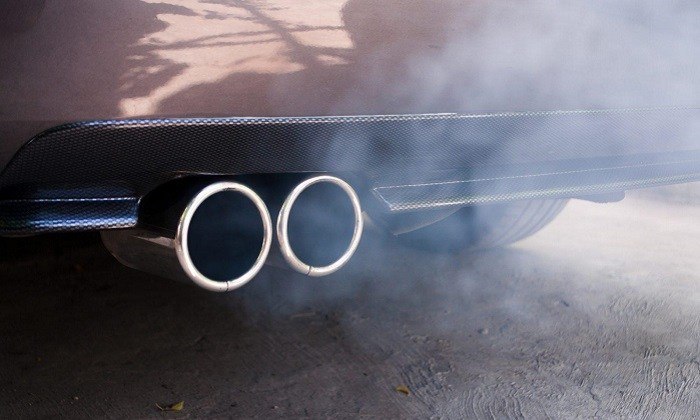by Joshua Thomas
As a motorist, you have probably noticed that the exhaust pipe is one of the hottest parts of your vehicle. But, chances are that you do not know exactly how hot it gets.
And while for many drivers how hot the exhausts pipe gets might not seem important, it is worth noting the temperature to expect so that you can easily tell when things are not okay in your vehicle.
Ultimately, how hot the exhaust pipe gets depends on various factors but, in this post, we try to make it clear the temperature to expect from your exhaust pipe. And we also explain a few other things concerning it you need to keep in mind.
Contents

The average and typical operating temperature for the exhaust system is between 300 and 500 degrees Centigrade. But this is still quite hot, which is why you should never touch the exhaust when the engine is running under any circumstances.
Also, the temperature will vary greatly at different parts of the exhaust pipe. The bends in the exhaust pipe near the cylinder and the sections close to the catalytic converter tend to be the hottest.
The temperature of the catalytic converter can easily go beyond 750 degrees Centigrade. And if any unburnt gasses are passing through it from the combustion chamber, it will get even higher than this.
For the mufflers, the peak temperature will come when you are driving rather than when the engine is idling.
The high temperature in the mufflers will result from the higher engine RPM, but it is also worth noting that other things like inefficient gas combustions can also lead to higher temperatures in the mufflers. On average, the temperature of the mufflers hardly goes beyond 650 degrees Centigrade.

Different factors will determine how hot your exhaust pipe can get. Hence, it will be inaccurate to give a specific number to how hot the pipe can get. Some of these factors will include the following.
An engine's level of performance is one of the main determinants of how hot the exhaust pipe gets as it will determine the temperature of the exhaust gases.
The higher the RPM the hotter the exhaust pipe will get. For example, when you are accelerating and the engine is at 2,000 RPM or even more the temperature of the exhaust gas can easily get to 600 degrees Centigrade or even more, which means you end up with a hotter exhaust pipe.
When the engine is idling at 700 RPM or less, the exhaust gas temperature will hardly go above 350 degrees Centigrade meaning your exhaust pipe will also be cooler.
The length of the exhaust tailpipe will also affect the temperature that it will have whether the vehicle is moving or stationary.
Given that all the heat comes from the engine, the longer the distance that the exhaust gases have to move the more heat they will lose before they exit the system.
What all this means is that vehicles with longer tailpipes will have relatively cooler exhaust pipes than those with shorter ones.
The condition of the vehicle’s engine will not only affect the performance but also other things like the amount of heat it will generate when in operation.
If your vehicle has an older or faulty engine that has issues and is also not performing optimally, it will be more likely to overheat.
And when the engine overheats, you can also expect your exhaust pipe and exhaust system, in general, to get hotter as the exhaust gases passing through will have a higher temperature.
The state of your exhaust system is also a huge determinant of the temperature that you will get on the pipe, and hence the need to keep it in good shape at all times.
If there are any bends or constrictions on your exhausts system, the temperatures on your exhausts pipe will be higher and can get to abnormally high temperatures which can lead to more problems. And this is because the hot exhaust gasses are not allowed to escape easily.

One of the main concerns that most motorists will have when it comes to exhausts heat is damage to the different vehicle components around the exhaust.
Typically, vehicle manufacturers have already thought about that and will probably not have anything that can get burnt easily around the exhausts. However, it still does not hurt to take extra precautions, and here are a few things you can do.
The first and most effective method to prevent heat from the exhausts from getting to other vehicle components will be to insulate the exhaust pipe.
Insulation keeps the heat inside while also not in any way affecting the performance of the exhaust pipe.
There are several things that you can use to insulate the exhaust pipe, but it is important to make sure what you use can take the heat. Exhaust tapes and wraps provide the best insulation, and they are widely available, inexpensive and also easy to use.
But, it is important to choose a wrap made from a good material like fiberglass, ceramic or silica as these materials can withstand higher temperatures than the exhaust produces. For example, fiberglass will start melting at 815 degrees Centigrade, which is much hotter than your exhaust can ever get.
If you cannot prevent the heat from escaping the exhaust pipe, the second best thing that you can do will be to reflect it away from the engine bay and other important components around it.
This can be done by adding a reflective material or barrier between the engine bay and your exhaust pipe.
Many manufacturers nowadays use embossed steel or aluminum heat shields that are mounted in the fresh air at least 1 centimeter from the exhaust manifold, and they will have an air gap to carry the heat away from the heat-sensitive components.
If you have an older vehicle model that does not have this heat barrier, your mechanic can help you set it or you can even make it a DIY project if you have the right skills.
Another alternative when it comes to protecting other vehicle components from the heat generated by the exhaust will be to insulate them.
In some instances, it will be easier to insulate these components than insulating the exhaust. And here you will only need to find a good insulating material that can be able to withstand the high temperature without allowing excess heat through.
For components like cables, hoses and hard lines, heat sleeves will be very useful at providing insulation to prevent heat damage. Heat sleeves made with a fiberglass backing and aluminum foil insulation will do the best job.
Besides insulating the components, heat sleeve will also help to reflect the heat away from them. The aluminum foil will reflect the radiant heat while the fiberglass material provides the insulation and also strengthens the sleeve.

While an exhaust pipe that is hotter or cooler than normal is a good indication of an engine or exhaust system problem, there are still many other reliable signs that should tell you when you have an issue with your exhaust. Here are some of these signs and symptoms.
Condensed exhaust pipes are not usual, and hence when you notice this problem, you need to have the exhaust pipes and entire exhaust system checked immediately.
As the exhaust gases pass through the catalytic chamber, they will be converted into water and carbon dioxide.
If the water is not able to escape, it will condense in the muffler and cause rusting that will eventually lead to tiny holes in the exhaust pipe that causes leakage. Hence, condensation in the pipes is a good sign you have exhaust problems.
One of the key functions of the exhaust system is to ensure that no fumes enter your vehicle by directing them out of the car through the tailpipes. Hence, if you start smelling fumes in the vehicle, that is a sign the exhaust is not working properly.
Besides carbon monoxide, you can also get the smell of gas in the vehicle when you have a faulty exhaust pipe, and the smell will result from leaks.
When there are leaks, the gases will escape from anywhere they can, and this is how they end up in your vehicle's cabin.
When your vehicle has an exhaust problem, the engine has to work harder to compensate for this and keep the vehicle moving. This, in turn, leads to a decrease in fuel as it will be burning more of it just to keep the vehicle on the go.
Also, it should be obvious that when the power and acceleration reduce, the fuel economy also dips significantly as they always seem to go hand in hand.
If you do not have the exhaust problem fixed as soon as possible, the problem will only become worse as the vehicle will continue increasing its fuel consumption.
This is perhaps the most obvious sign that you are having issues with your exhaust system. A hanging or dragging exhaust pipe is a sign of physical damage to the exhaust pipe.
If the problem is left unattended, it may lead to leaks in the pipe, which in turn causes a terrible and overly loud sound.
A hanging exhaust pipe will pose a danger to you and other motorists on the road as it can easily snap and lead to an accident.
While the power in your vehicle comes from the engine, the exhaust system also has an important role to play to ensure maximum power.
If you are having issues with the exhaust pipe or any other component in your exhaust system, you are likely to experience a reduction in power and acceleration.
The exhaust allows the engine to get rid of the combustion gasses which should explain why the exhaust pipe can get super-hot. And so if it is not working properly, the engine will also not function optimally, and hence the reduction in power and acceleration.
The exhaust pipe is tasked with carrying hot exhaust gases off the vehicle, and so the heat from the gases will also heat it fast when driving.
And while this pipe can get quite hot, the exact temperature it attains or how hot it gets will depend on various factors such as the engine condition and also the state of the exhaust system.
The optimal temperature should be between 300 and 500 degrees Centigrade when the engine is idling or when driving at moderate speeds. Anything excessively higher or lower than this can be an indication there is a problem that needs to be checked by a professional mechanic.
Sources
 |
 |
 |
 |

About Joshua Thomas
Joshua Thomas just simply loves cars and willing to work on them whenever there's chance... sometimes for free.
He started CarCareTotal back in 2017 from the advices of total strangers who witnessed his amazing skills in car repairs here and there.
His goal with this creation is to help car owners better learn how to maintain and repair their cars; as such, the site would cover alot of areas: troubleshooting, product recommendations, tips & tricks.
Joshua received Bachelor of Science in Mechanical Engineering at San Diego State University.
Just Car Care